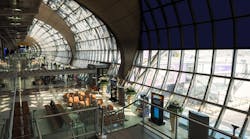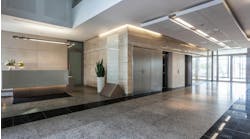Airports around the globe are being built or redesigned with a new approach to travel. No longer the dreary, stressful environment to be endured by travelers, airports are becoming a destination unto themselves. As the gateway to a nation, airports have the unique ability to represent a sense of place while creating a passenger experience with increasing sophistication.
Airport design represents an extraordinary opportunity for designers and architects to create beautiful, functional, efficient spaces with the passenger in mind with the use of smart glass.
The Benefits of Using Smart Glass in an Airport
All the properties that smart glass offers—energy efficiency, privacy on demand, unobstructed views, hygienic properties—can easily be utilized in airport design. In this article, we explore the numerous benefits of using smart glass when working on airport design and construction.
Energy Efficient
The use of smart glass in airport design can make a significant contribution to the airport’s sustainability goals by saving energy and reducing its carbon footprint. Smart glass windows can reduce the amount of solar heat entering the building, which lowers the cooling load necessary to keep the terminal at a carefully regulated temperature. The result is energy savings on cooling, shading and lighting costs. Smart glass also reduces equipment costs, including HVAC.
In addition, a consistently comfortable indoor climate creates a positive passenger experience, which is one of the primary goals of modern airport design.
Reduces Glare
One of the most compelling capabilities of smart glass is its ability to change from transparent to varying degrees of translucent instantly. By automatically tinting windows, smart glass can be a valuable asset to passengers who are waiting in line to board their plane or those who are enjoying the outdoor views in the boarding area, free from the discomfort of the sun’s intense rays.
Protects Against Disease
Smart glass is well-known for its easy-to-clean and anti-microbial properties. Especially with the COVID-19 pandemic drawing new attention to hygiene in airports, stopping diseases from spreading is a high priority in airport design.
Smart glass eliminates the need for shutters or curtains, which are not only expensive to maintain and clean, but also a major source of bacteria and germs. By replacing them with custom shading, smart glass can block up to 99% of light and lower levels of ultraviolet radiation, which can protect against serious diseases such as skin cancer, as well as reduce the fading of furniture, carpeting and flooring.
In addition, recent studies have shown that natural daylight passing through windows can disinfect many surfaces within 24 hours.
Improves Employee Health
Smart glass is a great solution for airport design because it allows for the immediate and precise control of light, has high light transmission levels and maximizes the amount of natural light entering an internal environment.
As many as 50,000 to 60,000 employees can work at a large city’s airport. That’s as many as the inhabitants of a small city! It is well known that natural light in the workplace improves employees’ physical health. It reduces stress and enhances creativity, helping them feel better emotionally and mentally, increasing performance and job satisfaction.
Maintains Views of the Outside
In addition to dynamically controlling sunlight and optimizing daylight, smart glass presents an opportunity for designers and architects to maximize views of the outdoors, which in turn enhances the comfort of travelers. It also improves the well-being of the thousands of people who work in an airport environment.
Smart glass eliminates the need for window treatments, including curtains, sun blinds, solar shades and electronic louvres, all of which can be very expensive to install, maintain and clean.
Creates Instant Privacy
Smart glass is often referred to as “privacy glass” because, with the flip of a switch, it can turn from transparent to varying degrees of translucent or opaque, creating instant privacy. There are many ways this remarkable advantage can be incorporated into airport design.
For example, designers can create the equivalent of office pods. Defined as self-contained spaces that give workers a private, quiet area to concentrate on their tasks at hand, they often look like ultra-modern phone booths with glass walls, a ceiling, single-person seating and the technology to get work done. They are small, and often can be moved around, providing unique flexibility. Some pods are designed for meetings, able to accommodate up to four people.
When made with smart glass, privacy pods allow occupants to look out, while those outside can easily see if it is occupied. Smart glass’s ability to switch from transparent to opaque and back to transparent in a matter of seconds gives the user total privacy when needed, and the opportunity to be seen and look out when desired. They are a unique, attractive and hygienic solution to easily creating a safe, quiet and clean space for harried travelers to enjoy instant privacy and a moment of calm.
Instant Messaging and Advertising
Smart glass film is a clear window tint-like material that is easy to install and creates a convenient opportunity for messaging and advertising. Smart glass can turn any glass surface into a projection screen. With the simple touch of a button, static glass can be turned into a dynamic HD screen to showcase visual content and capture the attention of travelers. Smart glass film can also be used to display flight changes or cancellations, and weather reports.
The use of smart glass is limited only by the imagination. Sleek, modern and hygienic, smart glass provides a myriad of solutions for airports, from instant privacy and solar shading to the creation of views and a clean, safe, energy efficient environment.


